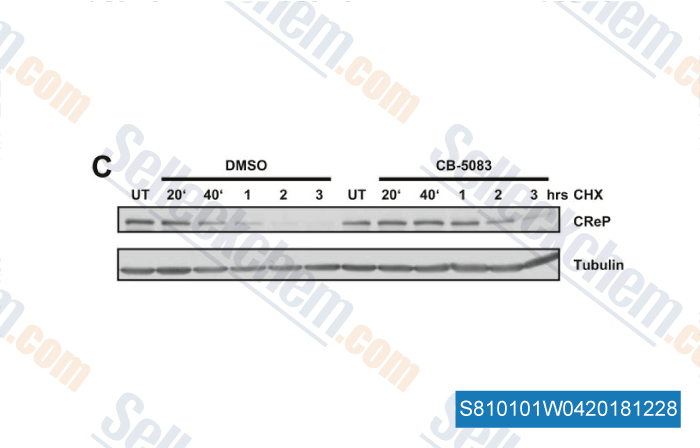|
Toll Free: (877) 796-6397 -- USA and Canada only -- |
Fax: +1-832-582-8590 Orders: +1-832-582-8158 |
Tech Support: +1-832-582-8158 Ext:3 Please provide your Order Number in the email. |
Technical Data
| Formula | C24H23N5O2 |
|||
| Molecular Weight | 413.47 | CAS No. | 1542705-92-9 | |
| Solubility (25°C)* | In vitro | DMSO | 82 mg/mL (198.32 mM) | |
| Ethanol | 29 mg/mL (70.13 mM) | |||
| Water | Insoluble | |||
|
* <1 mg/ml means slightly soluble or insoluble. * Please note that Selleck tests the solubility of all compounds in-house, and the actual solubility may differ slightly from published values. This is normal and is due to slight batch-to-batch variations. * Room temperature shipping (Stability testing shows this product can be shipped without any cooling measures.) |
||||
Preparing Stock Solutions
Biological Activity
| Description | CB-5083 is a potent, selective, and orally bioavailable p97 AAA ATPase inhibitor with IC50 of 11 nM. Phase 1. | ||
|---|---|---|---|
| Targets |
|
||
| In vitro | In A549 cells, CB-5083 causes significant K48 poly-ubiquitinated protein and CHOP accumulation as well as p62 reduction, and kills tumor cells with IC50 of 680 nM. [1] | ||
| In vivo | In mice bearing human HCT 116 colon tumor xenografts, CB-5083 (75 mg/kg, p.o.) significantly inhibits tumor growth. In mice bearing established human AMO-1 multiple myeloma and A549 lung carcinoma tumor xenografts, CB-5083 (100 mg/kg, p.o.) also results in significant tumor growth inhibition. [1] |
Protocol (from reference)
| Kinase Assay:[1] |
|
|---|---|
| Cell Assay:[1] |
|
| Animal Study:[1] |
|
Customer Product Validation

-
Data from [Data independently produced by , , Cancer Res, 2018, 78(14):3809-3822]

-
Data from [Data independently produced by , , Mol Oncol, 2016, 10(10):1559-1574]

-
Data from [Data independently produced by , , Mol Cell Proteomics, 2018, 17(7):1295-1307]
Selleck's CB-5083 has been cited by 45 publications
| hnRNPA2B1 represses the disassembly of arsenite-induced stress granules and is essential for male fertility [ Cell Rep, 2024, 43(2):113769] | PubMed: 38363675 |
| Targeting VCP potentiates immune checkpoint therapy for colorectal cancer [ Cell Rep, 2023, 42(11):113318] | PubMed: 37865914 |
| The FAM104 proteins VCF1/2 promote the nuclear localization of p97/VCP [ Elife, 2023, 12e92409] | PubMed: 37713320 |
| The generation of detergent-insoluble clipped fragments from an ERAD substrate in mammalian cells [ Sci Rep, 2023, 13(1):21508] | PubMed: 38057493 |
| Quantitative measurement of the requirement of diverse protein degradation pathways in MHC class I peptide presentation [ Sci Adv, 2023, 9(25):eade7890] | PubMed: 37352349 |
| VCP/p97, a pleiotropic protein regulator of the DNA damage response and proteostasis, is a potential therapeutic target in KRAS-mutant pancreatic cancer [ Genes Cancer, 2023, 14:30-49] | PubMed: 36923647 |
| The ubiquitin-dependent ATPase p97 removes cytotoxic trapped PARP1 from chromatin [ Nat Cell Biol, 2022, 24(1):62-73] | PubMed: 35013556 |
| The ubiquitin-dependent ATPase p97 removes cytotoxic trapped PARP1 from chromatin [ Nat Cell Biol, 2022, 24(1):62-73] | PubMed: 35013556 |
| TOLLIP-mediated autophagic degradation pathway links the VCP-TMEM63A-DERL1 signaling axis to triple-negative breast cancer progression [ Autophagy, 2022, 1-17] | PubMed: 35920704 |
| A drug repurposing strategy for overcoming human multiple myeloma resistance to standard-of-care treatment [ Cell Death Dis, 2022, 13(3):203] | PubMed: 35246527 |
RETURN POLICY
Selleck Chemical’s Unconditional Return Policy ensures a smooth online shopping experience for our customers. If you are in any way unsatisfied with your purchase, you may return any item(s) within 7 days of receiving it. In the event of product quality issues, either protocol related or product related problems, you may return any item(s) within 365 days from the original purchase date. Please follow the instructions below when returning products.
SHIPPING AND STORAGE
Selleck products are transported at room temperature. If you receive the product at room temperature, please rest assured, the Selleck Quality Inspection Department has conducted experiments to verify that the normal temperature placement of one month will not affect the biological activity of powder products. After collecting, please store the product according to the requirements described in the datasheet. Most Selleck products are stable under the recommended conditions.
NOT FOR HUMAN, VETERINARY DIAGNOSTIC OR THERAPEUTIC USE.
